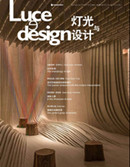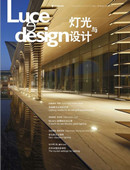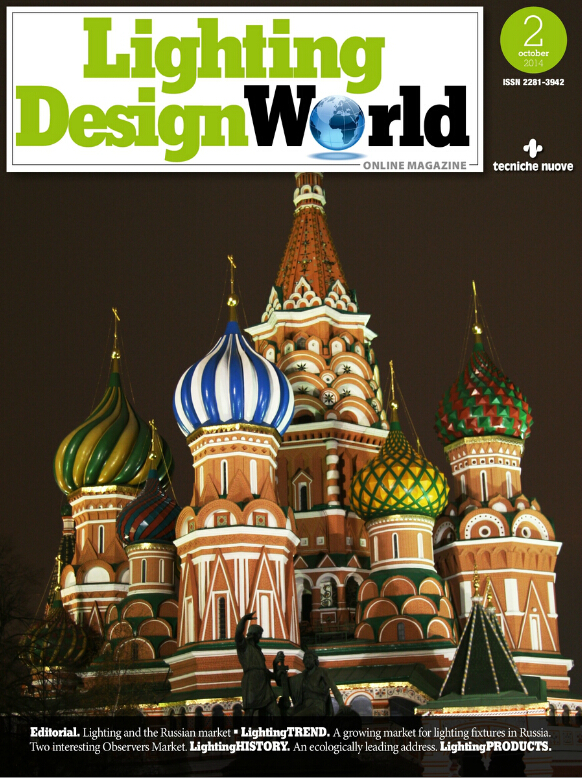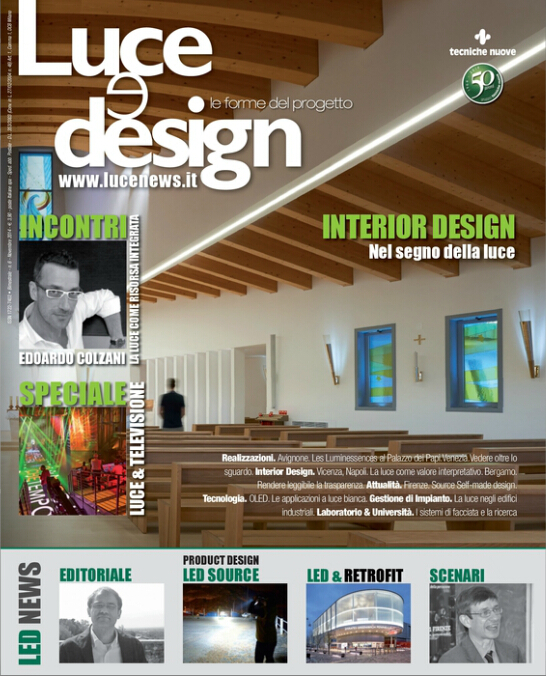俄罗斯圣彼得堡的艺术广场上有很多建于十四世纪的古建筑,它们的设计者是著名的建筑大师卡罗·罗西
Arts Square is an architectural complex based on the design by Carlo Rossi and founded at the beginning of the 19th century. It constitutes one of the oldest and most important urban areas of St. Petersburg
文:维克多·特斯维科夫
by Viktor Tsvetkov
图1:圣彼得堡艺术广场,图示为实施新照明方案后的广场
Picture 1: St. Petersburg, Arts Square. The finished illuminations
在圣彼得堡艺术广场的流连往返的人中有一半是来自世界各地的游客,这个广场上有很多著名的旅馆、博物馆、剧院和大型超市以及餐馆等。构成这一区域的核心建筑是米哈伊洛夫斯基大厦(现被用为俄罗斯国家博物馆)。环绕这座大厦的众多建筑围成了一个马蹄形——这是一种意大利建筑师们对城市进行规划时常用的设计——作用是突出建筑物的恢弘气势。广场上还有其它建筑,虽然它们的设计者都各不相同,但在建筑风格上都比较相似。
圣彼得堡艺术广场上的建筑物立面照明采用的是非常具有革新性质的彩灯照明方案。设想最初产生于2008年。经过设计师、客户还有伦斯维尔特市有关企业的共同努力,方案最终得以实现,并且成为圣彼得堡市的一大照明工程。在设计阶段遇到的最大困难是如何兼顾技术和审美的两方面要求:因为用活泼的彩灯给这些十四世纪的古建筑照明并非一件容易的事情。
图2:艺术广场,图示为一个地面上的内嵌式照明灯具的细节
Picture 2: Arts Square. A close-up of the custom-made lighting fixtures embedded in the pavement
照明在技术上的概念
艺术广场的照明方案在设计上做了适当的妥协,概念上基本是用均匀的白光把建筑物照亮,然后也运用了活泼的彩灯。在设计初期遇到了很多技术方面的问题,但最大的问题是如何确定灯具的位置:因为对着艺术广场的大楼正面不允许安装照明灯具,为此选择了一款高射灯,灯具本身被安装在生铁制成的高柱上。开始时曾想在多个灯柱上安装这种灯具,但考虑到外观效果,最终还是放弃了这个设计。没有采纳这一设计的另一个原因是射灯会使从楼里出来的人感觉晃眼,并且也会给周边的居民带来视觉不适。所以只好选择在大楼周边的人行路上埋设内嵌式灯具。尽管人行道下面的管道空间已经接近饱和——那里汇集了通信电缆、煤气管道、自来水和高低压电网等,但这个方案最终还是获得了很好的效果。
选择灯具
最初选择灯具时考虑都用彩灯,而且都是地下嵌入式,亮度方面要求很高,这样才能照亮整幢大楼,但结果并不理想。为了解决问题,客户方和设计师转而求助意大利的马蒂尼照明设计公司,希望对方能为他们在短时间内设计出一款合适的灯具。这家公司拥有专业的高级工程师,同时他们以往也有和圣彼得堡市合作的成功经验。在经过多次的试验后,马蒂尼的工程师决定弃用带过滤装置的设备,而选用 LED 射灯。最初遇到的技术问题集中在缩减灯具尺寸上,因为这部分要嵌入地下,所以灯具需要符合花岗岩石片的规格,而人行道下面可利用的空间非常有限,下面又有通讯电缆经过,同时还要考虑 LED 灯使用时会产生的大量的热等等。
图3:艺术广场
Picture 3: Arts Square
合理的方案
就这样马蒂尼公司的技术人员通过反复的研究和试验,在很短的时间内便制出一款名为Borgo5的灯具。由于规格的设计非常合理,只使用这一款灯具便解决了问题:到2008年11月为止,圣彼得堡已经安装了150盏这种射灯。由于工程尚未结束便获得一致好评,因此最终决定将全部灯具都将安装到位。为了获得最佳效果,还首次为圣彼得堡市设计和安装了一套配合照明工程的音乐设备,这个项目还体现了一点:这是第一次专门采用 LED 灯为城市照明,建筑物被照亮后成为了光与影的舞台,配上音乐整体效果获得了进一步的升华。
照明条件改善后,圣彼得堡艺术广场上最古老的米哈伊罗夫斯基剧院门前经常可以看见人们随着音乐翩翩起舞。广场上的音乐为电脑程控,通过一个外接的专用遥控器可以进行调节。照明设备则通过一个微处理器进行控制,计算机则由城市照明控制中心通过一个 GSM 适配器进行统一管理。夜幕降临,每隔15分钟灯光声就会随音乐的旋律发生变化(持续时间为5分钟),其余时间内建筑物则仅由白色的灯光照亮。
图4:灯具 Borgo 5 RGB 是一款灯具,框架采用的是重力铝铸造成型工艺,在地面嵌入安装后车辆可以在上面通过。光源选用的是 LED 灯(发光二极管)。三色 LED 灯(红-绿-蓝)构成单个灯头,可以照射出和控制成彩色光线,可对色调进行微调。灯泡的流明为4500lm,功率6500K(大小可调)。每个灯头由12个蓝色 LED 灯(4.5W), 24个绿色 LED 灯(4.5W)和13个红色 LED 灯(3W)组成,整个灯头的功率达250W,IP67
Picture 4: The Borgo 5 RGB is a roadway lighting fixture housed in gravity cast aluminium casing. The lighting uses LED (Light Emitted Diodes) technology as the light source. The matrix is composed of three types of LED (Red – Green – Blue), which allow for an accurate colorimetric balance in setting up and operating the colour beam emissions. The light flow is 4500 lm with a colour temperature of 6500 K (variable). The matrix is equipped with 12 blue LEDs (from 4.5 W), 24 green LEDs (from 4.5 W) and 13 red LEDs (from 3 W) giving a total power output of 250 W. IP 67
照明设计师与圣彼得堡市的建筑师进一步磋商后,决定选择线形 LED 灯为广场侧面的那些建筑物照明。为了满足这种特殊的要求,马蒂尼公司开发了一款名为 Aveline 的灯具,这是同类产品中结构最紧凑的一款——灯光的颜色与建筑物正面的颜色相近,因此色调上与建筑元素保持协调一致。这些墙面的照明都采用均匀的白光,而建筑物的窗户和窗框上的饰物也因此更显突出。
结论
2010年圣彼得堡的伦斯特公司在艺术广场东西两侧的建筑物上也安装了照明设备。负责照明设计的是坎德拉照明设计公司。目前广场上其它建筑物的照明也在设计之中。正如人们所看到的那样,这里的灯光将建筑与音乐合为一体,在光线的交相辉映下,天才建筑师们的杰作显得更加恢弘壮观。
图5,a-b:艺术广场:启用新的照明工具之前(a)和启用新的照明工具之后(b);
Picture 5 a , b: Arts Square, the illuminations before (a) and after (b) the installation of the new lighting system
照片提供:马蒂尼照明设计公司
Photo courtesy: Martini Illuminazione
Arts Square is a place of intense sightseeing activity by international tourists. Famous hotels, museums, theatres, large supermarkets and restaurants can all be found there. The centre of the architectural configuration is Michailovsky Palace (currently home to the Russian State Museum). All of the buildings surrounding the Square are positioned in a horseshoe formation – based on a city plan by the famous Italian architect – so as to underline the grandeur of the palace.
The facades of the other buildings that overlook the Square all have a similar architecture even though they were created by different architects. The idea to create a revolutionary and dynamic design lighting involving projecting colours on the buildings was born in the spring of 2008 as a result of the collaboration between designers, the client, and the public utility company Lensvet, who were working on the development of the city street lighting in St. Petersburg. The design process encountered difficulties both on the technical side and with regards to the aesthetic decisions to be made: it was in fact very difficult to integrate dynamic colour into a 19th century architectural complex. On one side there was the danger of the colours “degrading” the classic architecture of the buildings, and on the other there was the difficulty of convincing the architects responsible for the decisions relating to urban design, who were of a somewhat conservative disposition.
The Lighting engineering concept
The concept behind the lighting of the buildings in Arts Square was built on a compromise between the uniform illumination of the buildings with a white light and the possibility of having more dynamic coloured lighting according to a well-defined programme. Various technical problems were resolved during the design process. The main problem was deciding where to put the lighting fixtures: it was expressly forbidden to attach them to the outside of the buildings or for them to be directed towards Arts Square. The functional lighting of the Square was therefore achieved with lanterns hanging from artistic cast iron poles. The possibility of installing groups of fixtures on each pole was not practicable for obvious aesthetic reasons. Moreover these fixtures would have dazzled those who exit from the buildings and caused considerable inconvenience for the residents of the city. Therefore in order to project light onto the facades of the buildings there remained only one solution, which was to incorporate the lighting fixtures into the pavement alongside the buildings, the installation of which was achieved despite the existing congestion underneath the pavement what with a network of telecommunications and electrical wires as well as gas and water pipes.
Choosing the equipment
The next step was to decide on the most appropriate equipment for the job. Initial research into dynamic coloured lighting equipment that could be embedded in the pavement and that had the necessary light flow to illuminate the buildings, had not been crowned with success. The client and the designers therefore turned to the Italian company Martini Group with a proposal to develop customized equipment in a very short space of time. The company’s highly qualified technicians along with its practical experience gained in connection with several lighting projects already completed in St. Petersburg inspired confidence that it would be also successful in this project. After various trials it was decided to abandon the use of filtered lighting and to focus instead on LED lighting. An initial technical problem was posed by a series of restrictions on the dimensions of the formwork for the embedded casing which would house the lighting fixture. This was due to the dimensions of the granite slabs used in the pavement, the limited available depth, underground communications cables, and the need to guarantee the operating temperature for the powerful LED headlamps.
The chosen solutions
Working to a tight schedule, the Martini technicians developed, tested and produced the Borgo 5 device, the only one whose size could satisfy the requirements of the design project. 150 of these devices had already been installed and commissioned in St. Petersburg in November 2008. In the final phase of the design project it was decided to complete the installation with the provision of a musical soundtrack. This resulted in the creation for the first time in St. Petersburg, of a unique sound and lighting system for the buildings, and it was also the first large urban project achieved exclusively with LEDs. In this way the exterior of the buildings become more like a stage for the dance of light, an effect that is amplified by the classical music. Furthermore, since one of the oldest buildings, the Michailovsky Palace, is among those that overlook the square, people can often be seen dancing to the music there. The whole show is controlled by a computer located externally in a special control panel. The trajectory of the lighting equipment is controlled through the DMX protocol, while the computer functions are checked from the city lighting control centre via GSM modem. Every evening the musical light show is switched on for a brief period (up to 5 minutes) every 15 minutes. The rest of the time the buildings are bathed only in white light. After further consultation with the city architects regarding lighting the lateral walls of the buildings, it was decided to use LED linear lighting equipment. For this specific application the Martini Group developed Aveline, the most compact device of this type of product and, since it is the same colour as the buildings’ walls, one that fits in well with the architectural components of the buildings. These walls are illuminated with a uniform white light that exalts the ornamentation of the windows and the cornices.
Conclusion
In 2010 the St. Petersburg based Lensvet company finished setting up the artistic lighting equipment for the facades of the buildings on the east and west sides of the square. The lighting design project was developed entirely by Studio Candela. Other lighting design projects are currently underway for the other buildings in Arts Square. The result of all this will be the achievement of a unique blend of music and architecture that will enhance even more the beauty and the grandeur of the masterpieces created by this brilliant architect.
图X:针对安装位置对正对广场的建筑物上的灯具进行研究
X: Study of the positioning of the lighting equipment used for the facades overlooking the Square
艺术广场
俄语名为:Площадь Искусств),也被称为:Ploščad Iscusstv’,是圣彼得堡市最重要的广场之一,这里有很多相同名字的博物馆和剧院等。
广场以北是米哈伊罗夫斯基大厦,其设计者也是卡罗·罗西,该建筑建于1819年至1825年间;广场南侧对着 Ital’janskaja Uliza 大厦有几家剧院,其中最著名的是 Filarmonica Šostakovič 剧院;在 ‘Uliza Michailovskaja 大厦的一角是 Prospettiva Nevskij 广场,它正对着的是欧洲大饭店,这家饭店也是圣彼得堡最豪华的酒店之一。
ARTS SQUARE
Arts Square (in Russian Площадь Искусств), otherwise known as Ploščad Iscusstv’, is one of the main squares in St. Petersburg and it owes its name to the numerous museums and theatres that surround it. The Michailovsky Palace, which was designed by the architect Carlo Rossi between 1819 and 1825, is on the North side of the Square while the Southern boundary is lined with various theatres that overlook the Ital’janskaja Uliza. The main one of these is the Šostakovič Philharmonic Hall on the corner of the Uliza Michailovskaja, which joins the Square to the Nevsky Prospect, opposite the Hotel Europa, one of the oldest and most luxurious hotels in the city.
图Y:维克多·茨韦特科夫,坎德拉照明工作室的创建者和负责人
Y: Viktor Tsvetkov, designer, founder and director of Studio Candela
参与设计的大师们
负责圣彼得堡广场照明工程的是坎德拉照明设计公司,该公司成立于2003年,它同时也是斯巴达戈商业公司下属的一家分公司。该公司的工作室主要为建筑和景观进行照明设计,包括为街道、厂房、商业场所和办公室等各种空间进行照明设计。斯巴达戈商业公司成立于1993年,他们也是圣彼得堡的 GE 照明公司(USA)的代理。自成立以来,该公司下属的各分公司一直致力于为城市提供最新的照明技术和设备。在这些年来,坎德拉工作室为圣彼得堡的很多重要建筑物提供了照明方案。工程所涉及的建筑物有:Mariinsky 大厦、Smolny 教堂、Isaakiievsky 教堂、Petropavlovskaya 古城墙、de l’Ermitage 博物馆、美术学院和电信塔楼等。坎德拉工作室的设计方案多次获得 GE 爱迪生大奖,并在“俄罗斯照明设计大赛”中一举夺魁。这家设计公司还与世界最先进的照明灯具厂家进行合作,马蒂尼照明设计公司就是他们的合作者之一。
The stakeholders
The St. Petersburg project management was undertaken by the company Studio Candela, founded in 2003 and affiliated to the Spdg-Commercial company. The activities of this studio are focussed on architectural and landscape lighting design, functional street lighting and interior lighting for commercial and corporate buildings. Spdg-Commercial began its activities in 1993 and is the distributor for GE lighting (USA) in St. Petersburg. Since its foundation, the company has worked constantly to incorporate the most innovative lighting systems into the city. Over the years the Studio has dealt with numerous important construction projects in St. Petersburg. Among the most well-known of these are the Mariinsky Palace, the Smolny Dome, the Isaakiievsky Dome, the Petropavlovskaya Fort, the Hermitage Museum, the Art Academy and the Telecommunications Tower. Studio Candela’s projects have received numerous accolades such as the GE Edison Award as well as recognition as winner of the “Russian Lighting Design” competition. The company collaborates with the most important global producers of lighting equipment, amongst whom the Martini Group is a key partner. The founder and Director of Studio Candela is Viktor Tsvetkov.











































